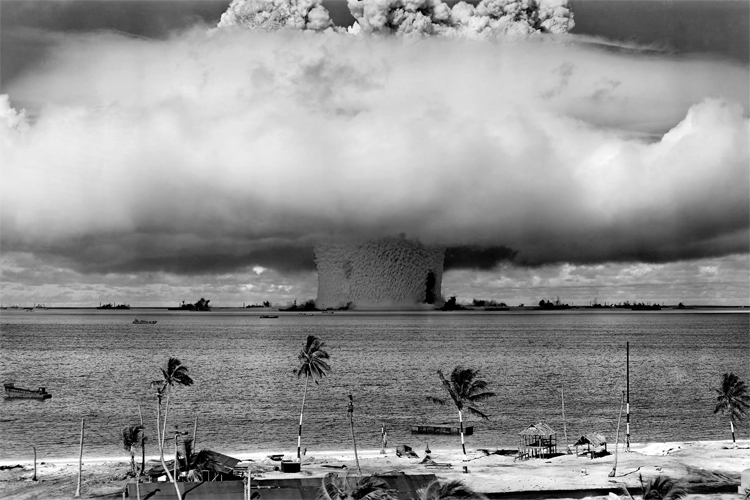In the world of artificial-generated waves, surf pools share their human touch with rather dangerous activities. Here's how underwater explosions (UNDEX) created some of the biggest waves Planet Earth has ever seen.
The saga of underwater detonations takes us back to the throes of the Cold War (1947-1991), a time of deep tension and scientific rivalry between the United States and the Soviet Union.
During this era, the world bore witness to numerous nuclear tests conducted in an array of environments, each with its own unique set of ramifications.
However, it was the underwater nuclear tests that truly captured the world's attention due to their visually impressive and environmentally impactful results.
The United States was the first to dive into underwater atomic testing with "Operation Crossroads" in 1946, just one year after the devastating effects of nuclear weaponry were laid bare in Hiroshima and Nagasaki.
The operation consisted of two separate tests, "Able" and "Baker," conducted at the Bikini Atoll in the Marshall Islands.
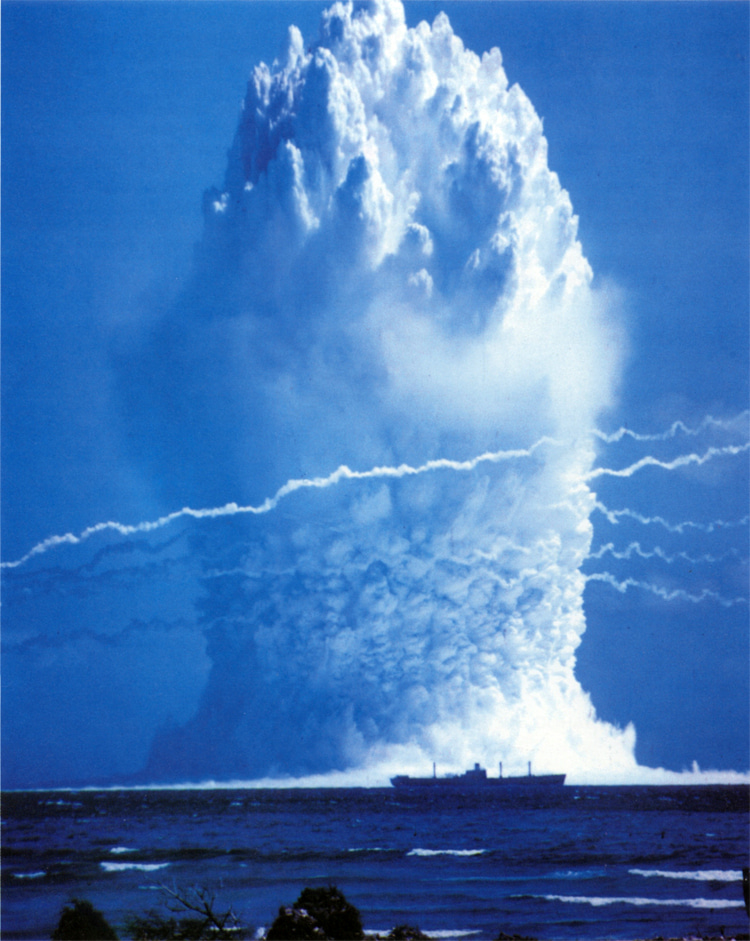
A 360-Degree Blast
The goal was to assess the impact of nuclear weapons on naval warships, observing the destructive power of these weapons when detonated beneath the ocean's surface.
Over the following decades, numerous other countries, including the Soviet Union, France, and the United Kingdom, conducted their own underwater nuclear tests.
This was driven by several factors:
- Military Strategy: Understanding the effects of an underwater explosion was key for naval warfare tactics;
- Scientific Curiosity: The desire to study the effects on marine ecosystems, water, and the atmosphere;
- Geopolitical Showmanship: A visible and potent demonstration of national might during the Cold War era;
Unfortunately, these tests had severe impacts, particularly on marine life and nearby infrastructures.
Underwater nuclear tests performed close to the surface may disperse radioactive water and steam over a large area.
These detrimental effects led to the banning of underwater detonation of nuclear weapons by the 1963 Partial Nuclear Test Ban Treaty (PTBT) and the 1996 Comprehensive Nuclear-Test-Ban Treaty (CTBT).
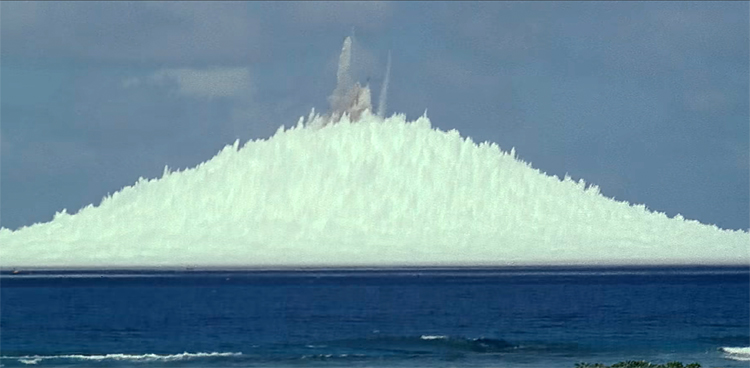
Science Beneath the Surface
The waves generated by underwater atomic explosions are often described as a type of "shock wave" due to their origins and behavior.
Unlike traditional ocean waves, which are driven by wind and tides, these waves are formed by the rapid displacement of water by the explosion's energy.
The behavior of these waves, however, differs greatly depending on whether the explosion occurs in shallow or deep water.
- Shallow-Water Detonations: Here, the blast wave is constrained by the water's surface and seabed, producing a surface plume and potentially massive waves. The "Baker" test, for instance, created a water column over 1.3 miles (two kilometers) high and 600 yards across, with waves reaching the atoll's shores at 20 feet (six meters) high;
- Deep-Water Detonations: In these, the blast forms a rapidly expanding bubble of hot gases, creating a shock wave that travels in all directions. The ocean's pressure may cause this bubble to collapse and rebound, creating oscillating waves. These waves tend not to reach the surface with the same intensity, resulting in smaller surface waves;
The behavior of waves created by underwater atomic explosions is a complex phenomenon. It hinges on numerous factors, including:
- The distance from the blast;
- The energy of the explosion;
- The depth of the detonation;
- The depth of the water;
The size and nature of the explosive charge, as well as the presence, composition, and distance of reflecting surfaces such as the seabed, surface, and thermoclines, also play significant roles.
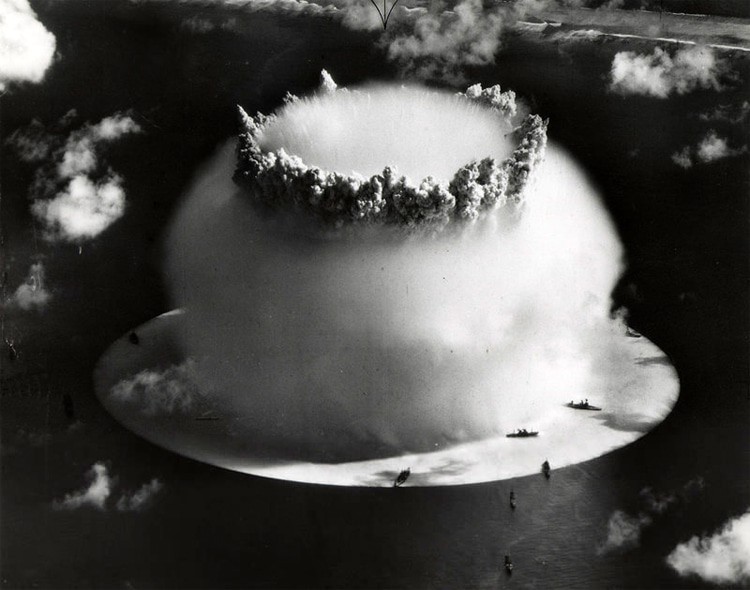
"Operation Crossroads": Unleashing an Atomic Maelstrom
In the world of atomic history, "Operation Crossroads" holds a particular significance, representing the first series of underwater nuclear tests.
These experiments, conducted in the Pacific Ocean's Bikini Atoll, became an iconic symbol of nuclear power's raw and devastating strength.
The climax of "Operation Crossroads" was the "Baker" test, which took place on July 25, 1946.
A 23-kiloton atomic bomb was detonated 88.5 feet (27 meters) beneath the water's surface.
The resulting explosion was both breathtaking and terrifying, a stark testament to the unbridled power of the atomic age.
The blast created a monumental plume of water, radioactively contaminated, that reached an astounding height of more than 1.3 miles (two kilometers).
This pillar of water, at its base, was approximately 600 yards across, a size difficult to comprehend.
The spectacle was further emphasized by the shock waves that radiated out from the blast's epicenter.
The surface waves created by the "Baker" test were similarly massive. Initial waves close to the explosion reached a staggering height of 100 feet (30 meters) or more.
These colossal waves, however, lost much of their energy as they traveled, with a set of nine waves reaching the atoll's shores at approximately 15 feet (5 meters) high - still enough to cause significant damage had this been a populated area.
In their relentless advance, these waves flung landing craft onto the island's sandy expanse, leaving them brimming with the churned remnants of the ocean floor.
The spectacle of "Operation Crossroads," particularly the impressive waves generated by the "Baker" test, forever imprinted the potent and devastating potential of nuclear power in the collective consciousness of humanity.
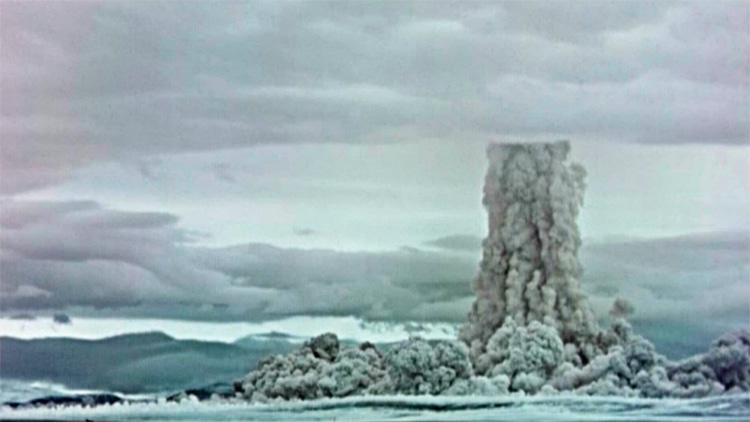
Soviet Union's Tsar Bomba: The Largest Underwater Test
While the United States conducted the first underwater atomic tests, it is the Soviet Union that holds the record for the largest.
The Soviets detonated a 50-megaton hydrogen bomb, known as the "Tsar Bomba," on Severny Island in October 1961.
While this was an air blast, not underwater, the colossal power of the Tsar Bomba underscores the scale of Cold War-era atomic testing.
However, it's important to clarify that the Tsar Bomba was not an underwater explosion; it was an air blast detonated 2.5 miles (four kilometers) above the Earth's surface.
Thus, it didn't create waves in the manner that an underwater explosion, like those in "Operation Crossroads," would have.
Nonetheless, Tsar Bomba's shock wave was of such power that it manifested significant surface effects, even without direct water displacement.
It produced a seismic shock, which registered as an artificial earthquake around the world, reaching a magnitude of 5.0 to 5.25 on the Richter scale.
In terms of water displacement, the massive heat and pressure from the Tsar Bomba would have created what's known as a thermal tsunami.
While not a tsunami in the traditional sense, these are large waves caused by rapid water heating.
This could have resulted in waves several meters high near the point of detonation.
However, precise details regarding the Tsar Bomba's effects on the sea surface remain elusive.
The secrecy shrouding Soviet nuclear tests means that comprehensive records are not readily available, leaving us with only estimates and indirect evidence of Tsar Bomba's unparalleled power.
From Atomic Waves to Tsunamis: A Clarification
Despite the scale of these events, they do not create tsunamis in the traditional sense.
Tsunamis are caused by the displacement of a large volume of water over a broad area, typically due to seismic events like earthquakes.
Underwater atomic explosions, however, displace water in a relatively small, localized area. Even the largest nuclear tests have failed to generate tsunami-like phenomena.
Curiously, "Operation Hardtack I," a series of nuclear tests conducted by the United States in the Bikini Atoll region, took place immediately before and after the legendary Lituya Bay earthquake, which produced the world's largest wave on record.
On July 9, 1958, the event produced a megatsunami and a wave estimated at 1,720 feet (524 meters) near the Gilbert Inlet, around 4,375 miles (7,000 kilometers) away from Bikini island.
